
The Bottom Line
Introduction, Drive Specifications, Pricing and Availability
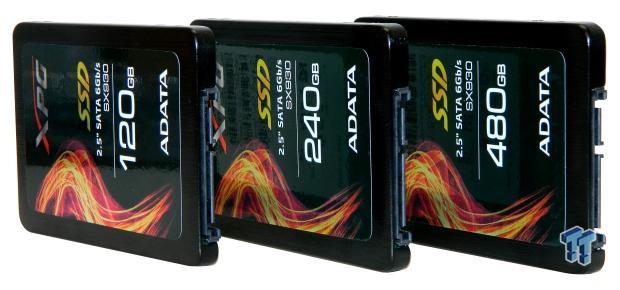
The "Value" segment of the SSD market is beginning to emerge as the majority market share of the SSD market as a whole. Although solid-state storage has come down considerably in price over the last year or so, an SSD remains a premium component demanding a premium price. As enthusiasts, we tend to want the fastest available SSD's and price is a secondary concern to us. However, the mainstream user does not see things as we do. Price is the mainstream user's primary concern and this is why we are seeing an explosion in the value segment of the overall SSD market.
ADATA is a long time purveyor of solid-state storage, and as a brand, they are one of the best out there. ADATA is looking to bridge the gap, if you will, with the best of both worlds. ADATA's goal with the XPG SX930 Series is to deliver premium performance and endurance in a low-cost package. ADATA feels there is a market for an SSD that can both compete with the pricing of value SSD's and the performance of premium SSD's. We tend to agree with ADATA in that respect.
ADATA is a fabless company, so they don't have the benefit of a proprietary controller, or access to an in-house pool of flash. What they do have is a good name and a reputation for quality, high performing solid-state memory solutions. ADATA has paired up with JMicron for the SX930. The SX930 is the first drive to market powered by the JMicron JMF670H controller. The JMF670H is a 32-bit single core ARM based 4-channel controller. The JMF670H employs an advanced BCH ECC error correction engine for high reliability and superior endurance. One of the benefits of going with a 4-channel controller is a lower power requirement, which in turn leads to increased notebook battery life. This all sounds a lot like a controller we are very familiar with, Silicon Motion's SM2246EN.
On the NAND front, ADATA is utilizing Micron 16nm 128Gbit MLC synchronous flash for the SX930 Series. We like the choice; 16nm Micron MLC flash is a proven performer. ADATA is taking things a step further and utilizing binned flash for the SX930. ADATA is calling this binned flash "Enterprise-grade MLC plus NAND Flash". To be clear, this is not actual enterprise quality flash, it is instead select MLC 3K P/E consumer flash that carries a five-year warranty. To further boost performance, the SX930 is employing a pseudo SLC (pSLC) acceleration layer. This acceleration layer is facilitated via the drive's JMF670H controller. JMicron calls this acceleration layer programming Write Booster. The size of the drives Write Booster layer varies by capacity; 4GB for the 120GB SX930, 8GB for the 240GB SX930 and 16GB for the 480GB SX930.
ADATA feels that their XPG SX930 will be very appealing to gamers and markets the drive as a "Gaming SSD". In an effort to appeal to enthusiast's ADATA has revamped the look of the SX930 series. Gone is the passive looking humming bird logo, instead we now have flames for a more aggressive looking SSD. Personally, I find the new look more appropriate for the gaming community. The XPG 930 comes with an extensive accessory package that includes a 3.5" to 2.5" drive tray, 9.5mm stick-on spacer and an Acronis key for drive cloning.
On paper, the XPG SX930 looks like it will be a good performer; now let's see for ourselves what these SSD's have under the hood.
Specifications: ADATA XPG SX930 120GB, 240GB and 480GB SATA III SSD
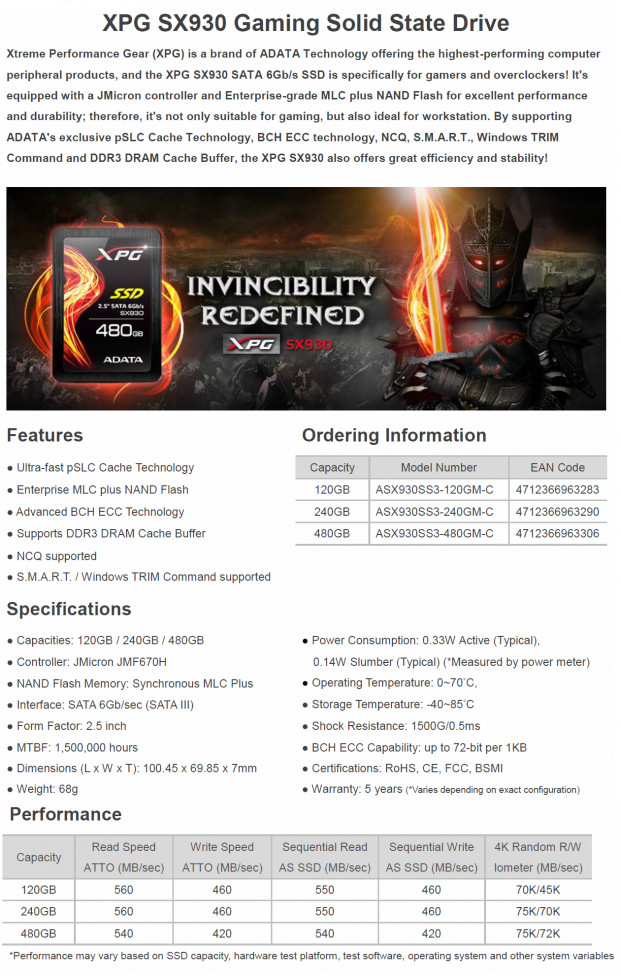
ADATA's XPG SX930 SATA III 2.5" FF SSD is available in three capacities: 120GB, 240GB, and 480GB. Sequential read performance via ATTO, varies slightly by capacity, 560 MB/s for the 120-240GB and 540 MB/s for 480GB. Sequential write performance also varies by capacity, 460 MB/s for 120-240GB and 420 MB/s for 480GB. Looking at ADATA's listed AS SSD performance, we find an obvious error with the sequential read speed. 550 MB/s isn't going to happen running AS SSD on any SATA III SSD. We believe ADATA is actually referring to CDM, not AS SSD.
4K Random Read is spec'd as 70,000 IOPS at 120GB and 75,000 at 240-480GB. 4K Random Write is spec'd as 45,000 IOPS at 120GB, 70,000 at 240GB and 75,000 at 480GB. LBA addressing is handled by a single DDR3 DRAM package that varies in density by capacity. Slumber power consumption is listed correctly at .14W however, active power consumption is not listed correctly.
ADATA backs the SX930 with a five-year limited warranty. No TBW or endurance rating is given.
Drive Details
ADATA XPG SX930 120GB, 240GB and 480GB SATA III SSD
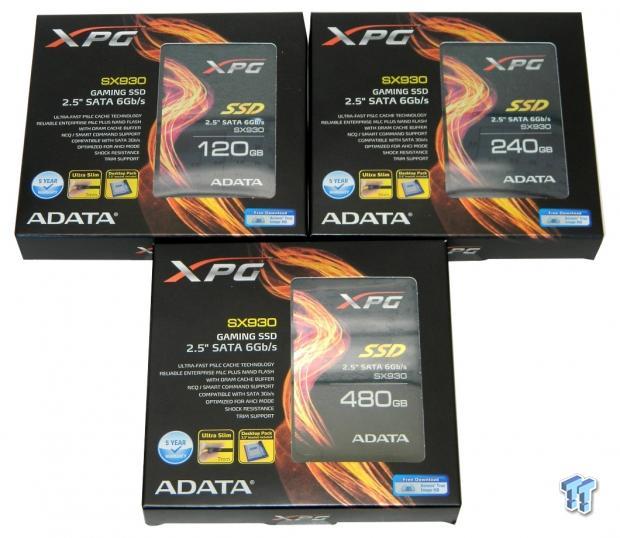

The XPG SX930 is packaged in a bronze colored box. The face of the drive is viewed through a clear plastic window on the front of the box. Packaged contents, free cloning software, the drive's five-year warranty and features of the drive are advertised.
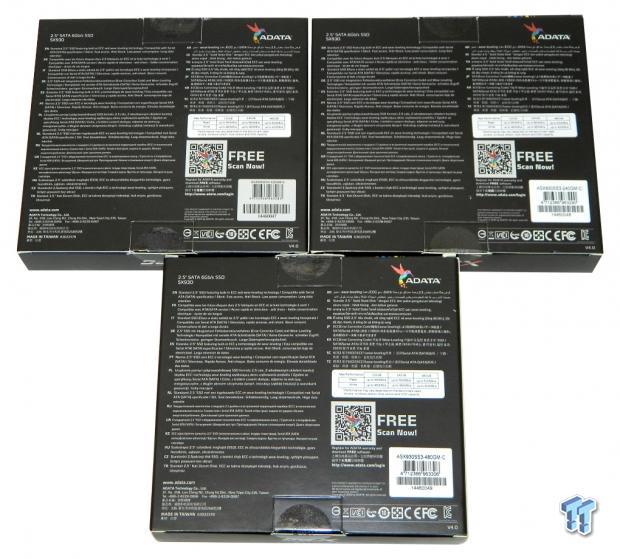
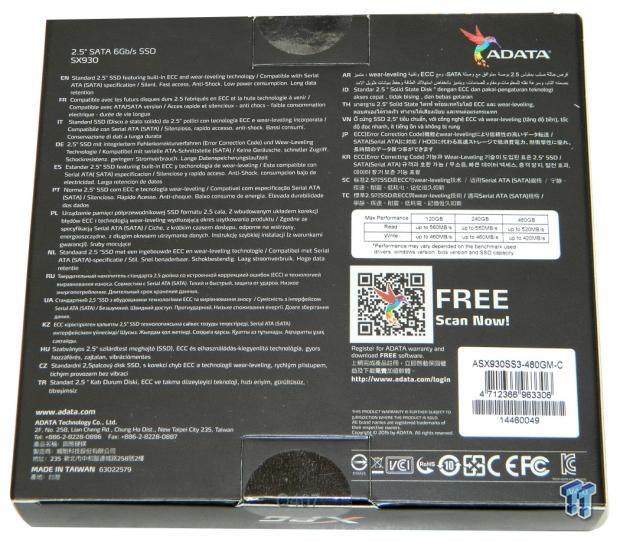
The back of the packaging lists some performance specifications.
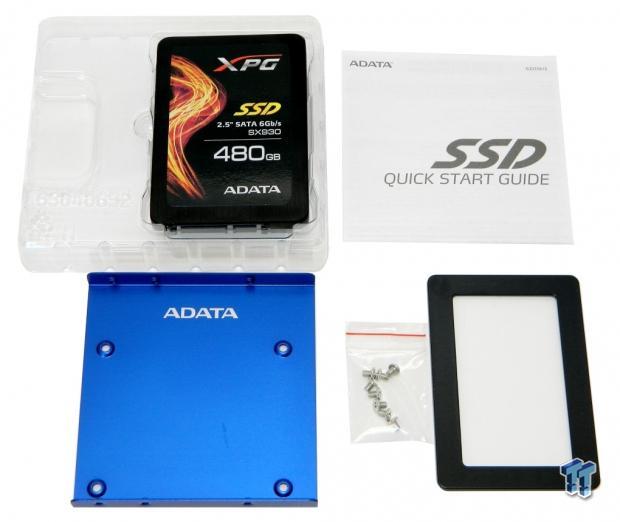
Inside the box, the drive is cradled in a clear plastic tray. A drive adapter tray, 9.5mm spacer screws, and a quick start guide are included as part of the package.
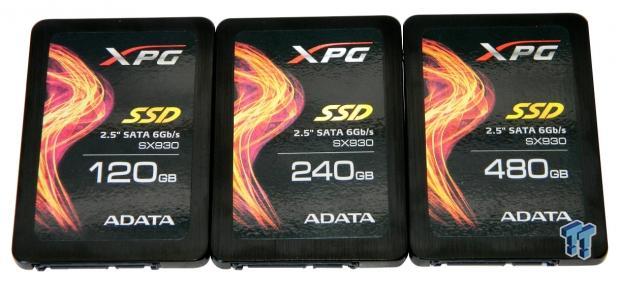
The front facing of the drive's enclosure is covered by a black, flame emblazoned label. The label lists the drive's capacity.
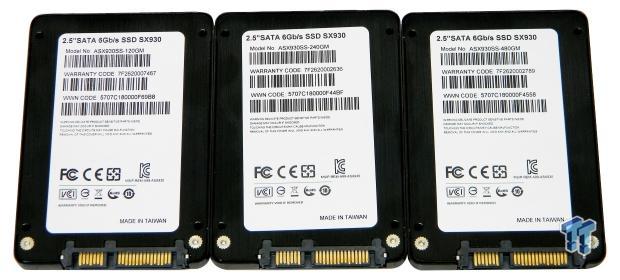
Centered on the back half of the drive's enclosure is a manufacturer's label that lists model number, warranty code and WWN code.
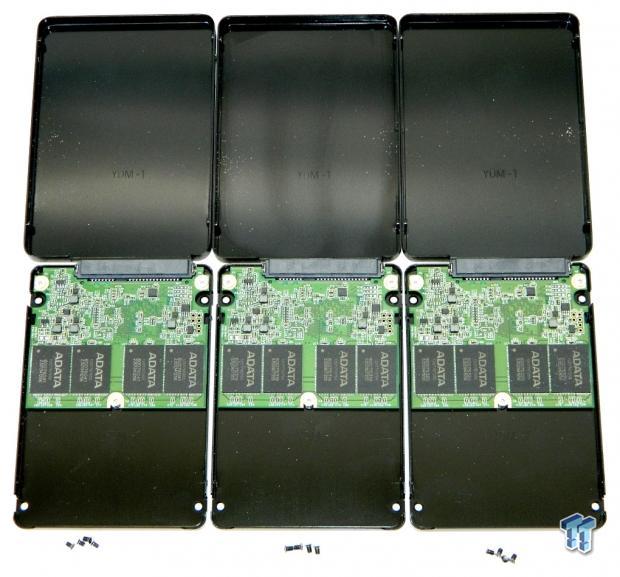
The drive's enclosure is formed from stamped aluminum, painted black. The 1/2 length PCB is secured to the enclosure by three screws.
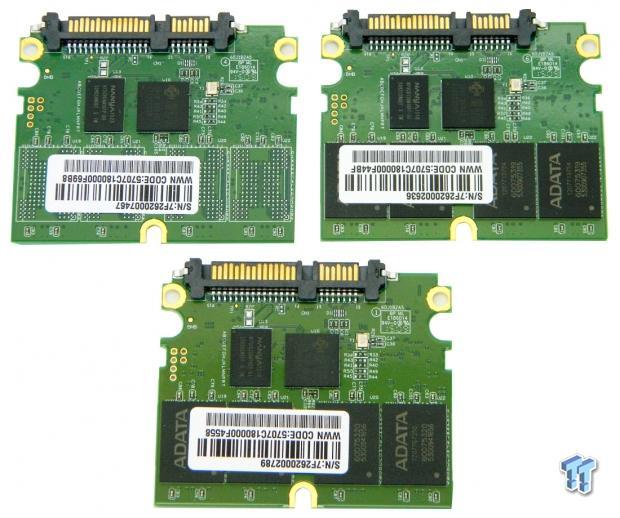
In addition to a controller and DRAM package, there are four flash packages on this side of the PCB for both the 240 and 480GB models. The 120GB model has no flash packages on this side of the PCB.
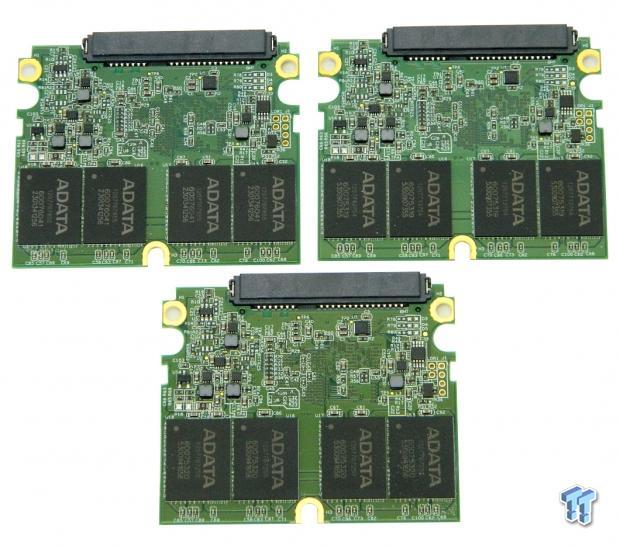
This side of the green 1/2 length PCB is populated with four flash packages for all three models.
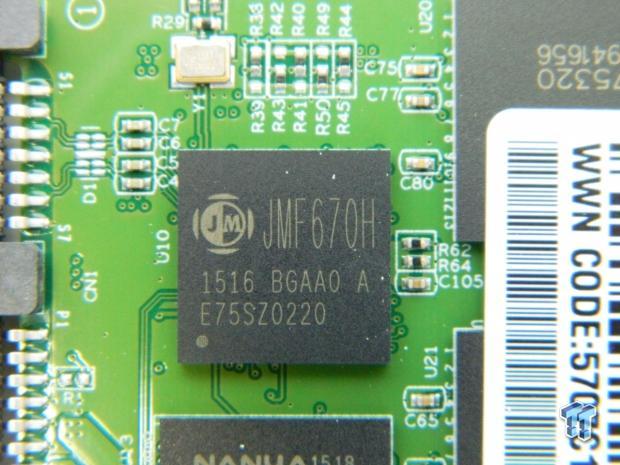
A close-in view of the JMicron JMF670H 4-channel controller that powers the SX930.
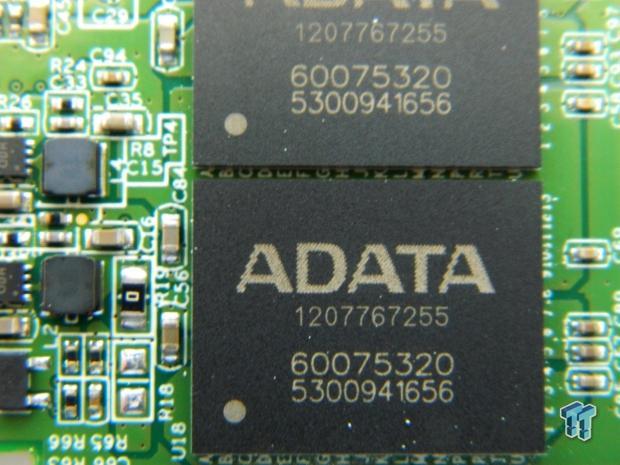
A close-in view of one of the drive's ADATA branded Micron flash packages.
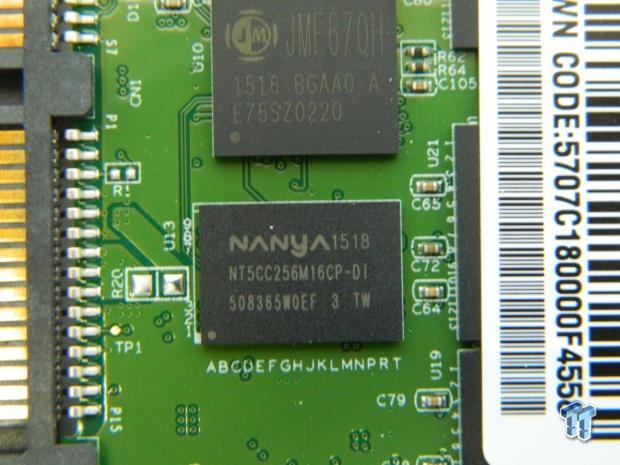
Finally, a close-in view of the drive's NANYA DDR3 DRAM package.
Test System Setup and Properties
Test System Configuration
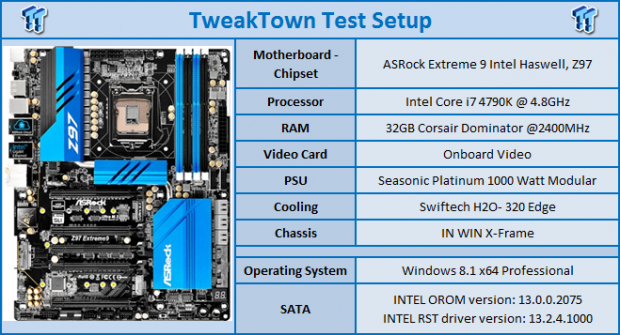
We would like to thank the following companies: ASRock, Crucial, Intel, Corsair, RamCity, IN WIN, and Seasonic for making our test system possible.
Drive Properties
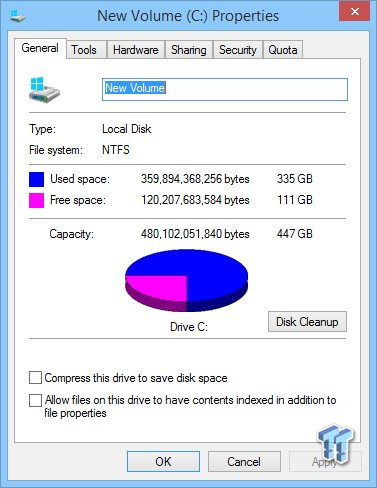
The majority of our testing is performed with our test drive as our boot volume. Our boot volume is 75% full for all OS Disk "C" drive testing to replicate a typical consumer OS volume implementation. We feel that most of you will be utilizing your SSD's for your boot volume and that presenting you with results from an OS volume is more relevant than presenting you with empty secondary volume results.
System settings: Cstates and Speed stepping are both disabled in our system's BIOS. Windows High Performance power plan is enabled. Windows write caching is enabled, and Windows buffer flushing is disabled. We are utilizing Windows 8.1 64-bit for all of our testing except for our MOP (Maxed-Out Performance) benchmarks where we switch to Windows Server 2008 R2 64 Bit.
We will be charting all three capacities, and presenting benchmark screen-shots of the XPG SX930 480GB.
SSD Toolbox
ADATA SSD Toolbox
ADATA's SSD Toolbox drive management software is feature rich and provides tools that compliment SSD ownership. To download ADATA's SSD Toolbox drive management software, click here.
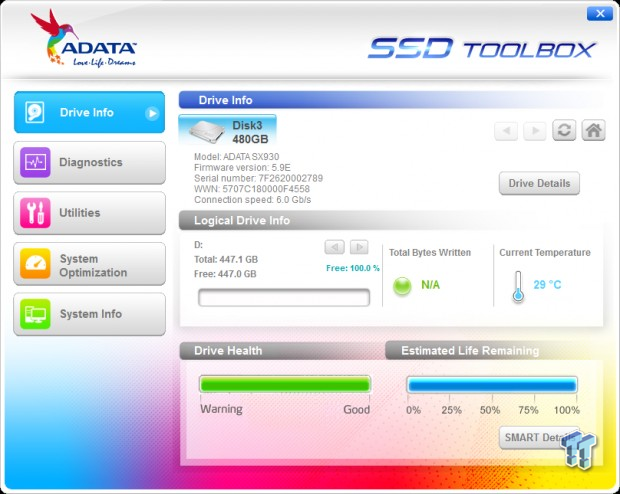
The Drive Info tab lists drive information, health and estimated life remaining. SMART data can be accessed by clicking on the Drive Details button.
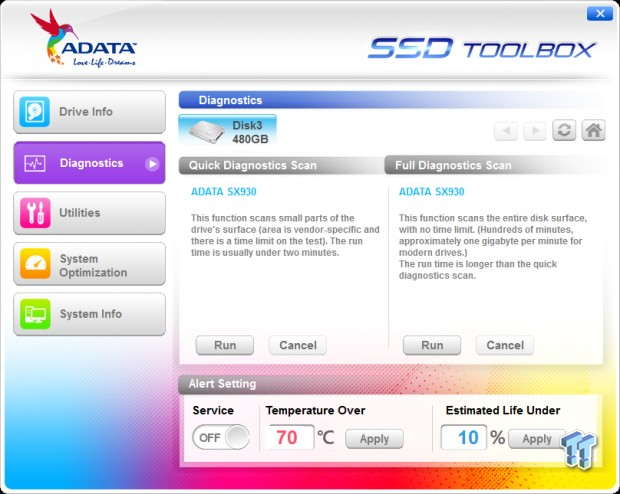
The Diagnostics tab allows you to run a quick or full scan of the drive. You can set temperature and estimated life remaining alerts here as well.
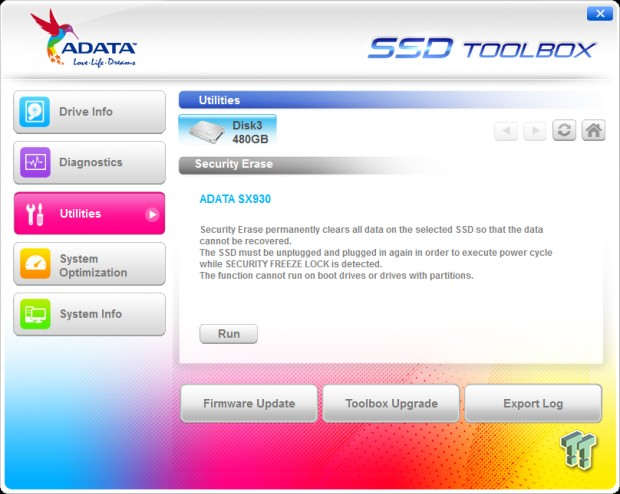
The Utilities tab allows you to secure erase the drive, update firmware, upgrade the toolbox and export a log file.
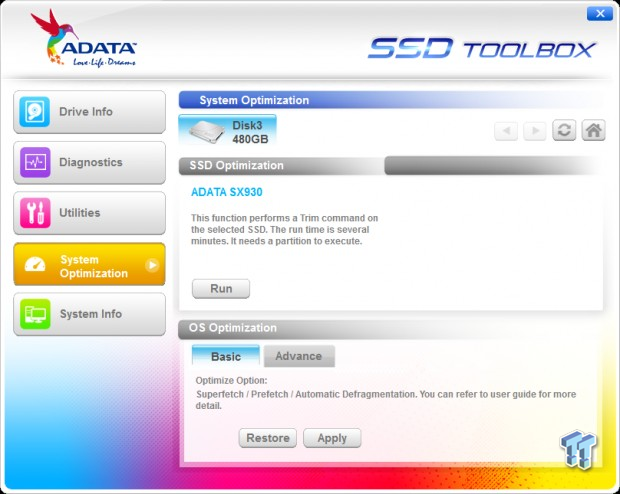
The System Optimization tab allows you to TRIM the SSD and automatically apply SSD optimized settings to your OS.
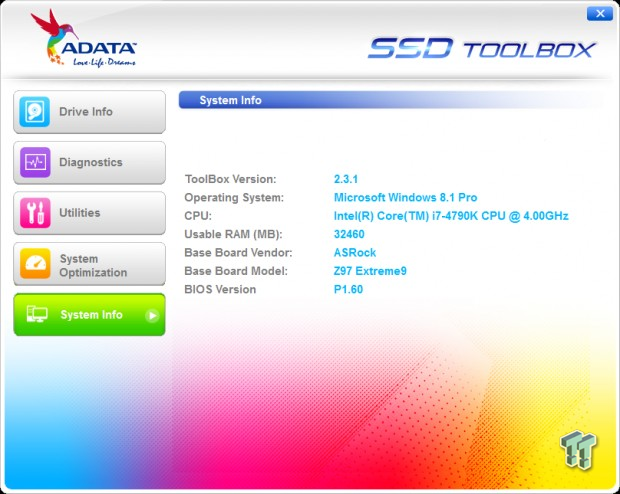
The System Info tab lists basic information about your system.
Synthetic Benchmarks - ATTO & Anvil Storage Utilities
ATTO
Version and / or Patch Used: 2.47
ATTO is a timeless benchmark used to provide manufacturers with data used for marketing storage products.
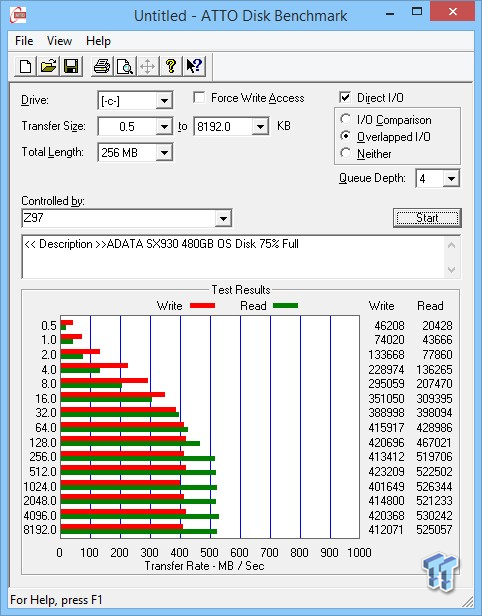
Sequential read/write transfers for the 480GB SX930 max out at 518/413 MB/s. Keep in mind this is our OS volume 75% full, and we are properly converting KB to MB.
Sequential Write
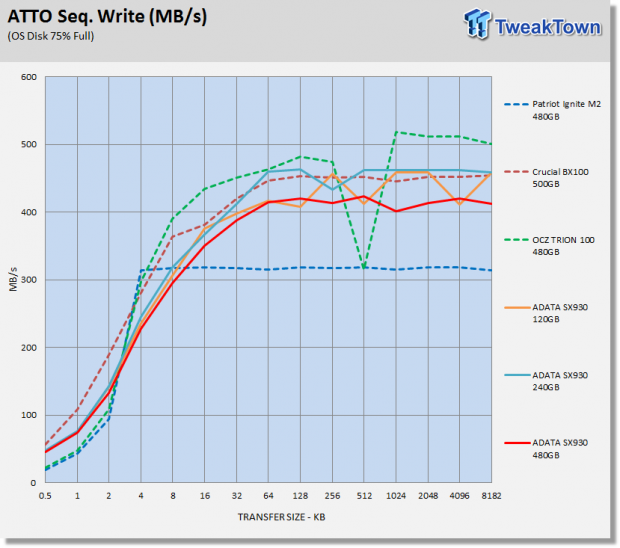
Both the 120GB and 240GB SX930's outperform the higher capacity 480GB model.
Sequential Read
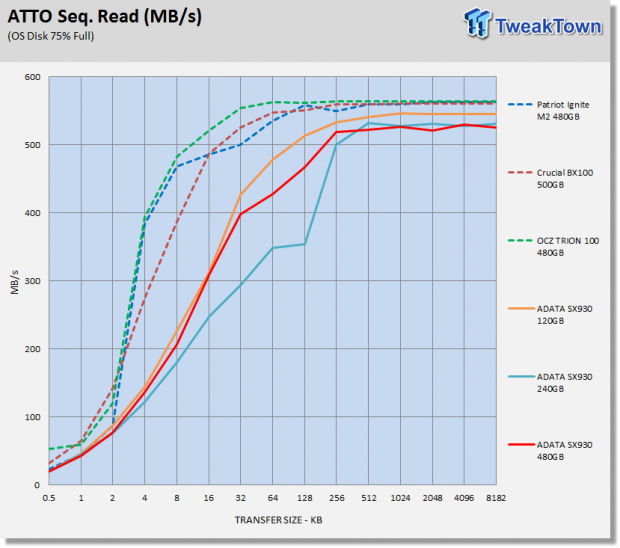
The SX930's lag a bit behind the rest of the field. The 120GB SX930 delivers the best sequential read performance of the three capacity points.
Anvil Storage Utilities
Version and / or Patch Used: 1.1.0
Anvil's Storage Utilities is a storage benchmark designed to measure the storage performance of SSD's. The Standard Storage Benchmark performs a series of tests; you can run a full test or just the read or write test, or you can run a single test, i.e. 4k QD16.

Scoring
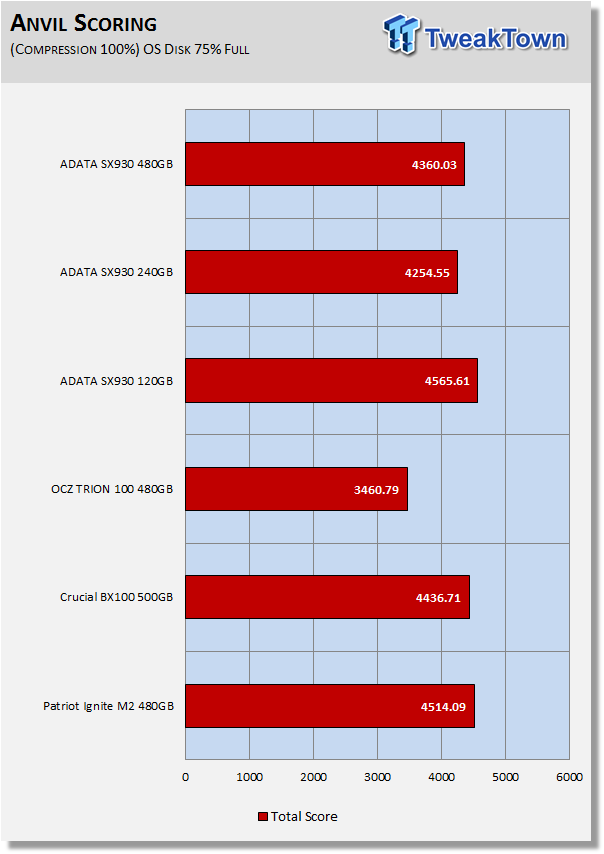
Anvil's scoring gives a good indication of a drives overall performance. Scoring is exactly what we would expect from a 4-channel controlled SSD. The 120GB SX930 outperforms the rest of the SSD's on our chart.
(Anvil) Read IOPS through Queue Depth Scale
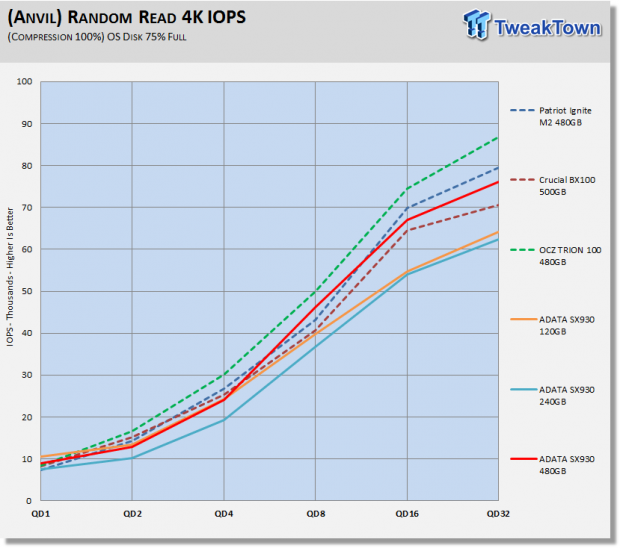
The 120GB SX930 has the best 4K QD1 random read performance of any of the drives on our chart. The 480GB SX930 has the better performance of the three from QD4-QD32. OCZ's TRION outperforms the rest of drives on our chart.
(Anvil) Write IOPS through Queue Scale

The 240GB SX930 outperforms its brethren at all measured QD's. The BX100 has a better performance curve than the SX930's and the Ignite has the best performance curve of the drives on our chart.
Synthetic Benchmarks - CrystalDiskMark & AS SSD
CrystalDiskMark
Version and / or Patch Used: 3.0 Technical Preview
CrystalDiskMark is disk benchmark software that allows us to benchmark 4k and 4k queue depths with accuracy. Note: Crystal Disk Mark 3.0 Technical Preview was used for these tests since it offers the ability to measure native command queuing at QD4.
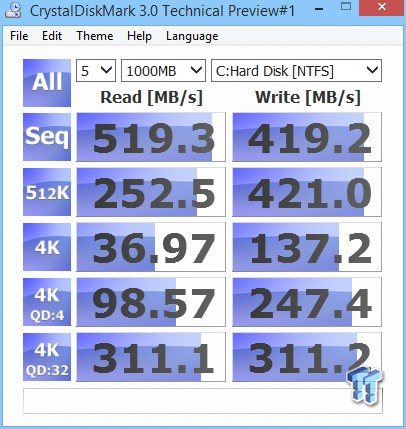
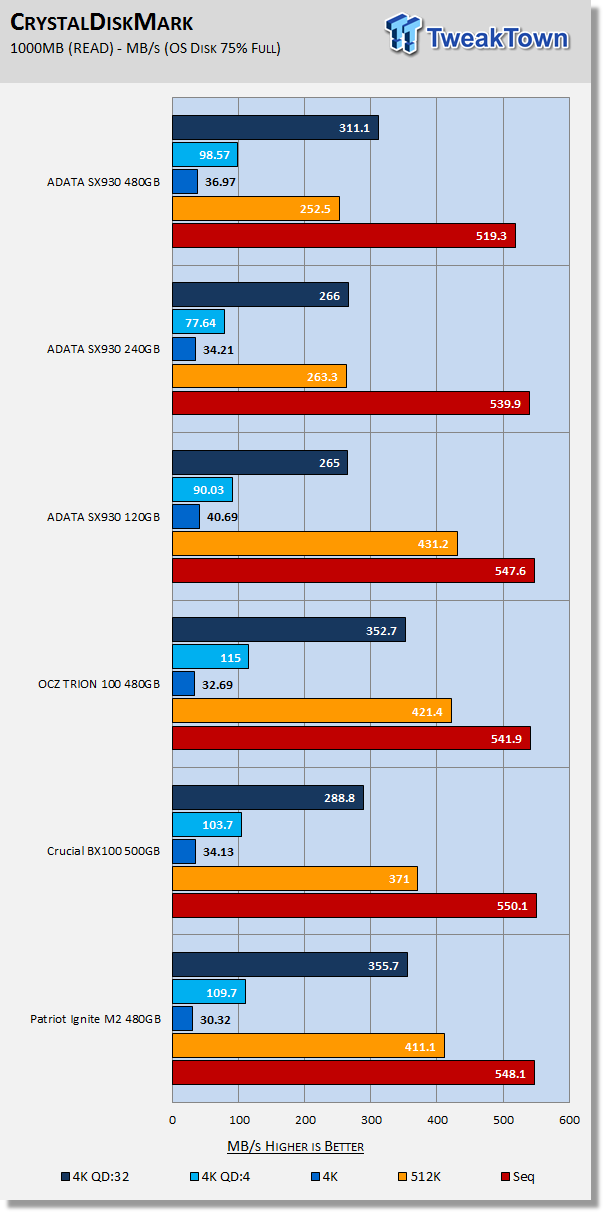
Our drive is loaded up with data so we are not able to achieve the quoted sequential read speed given by ADATA. We note that the 120GB SX930 has outstanding single queue random read performance, by far the best performance of the drives on our chart.
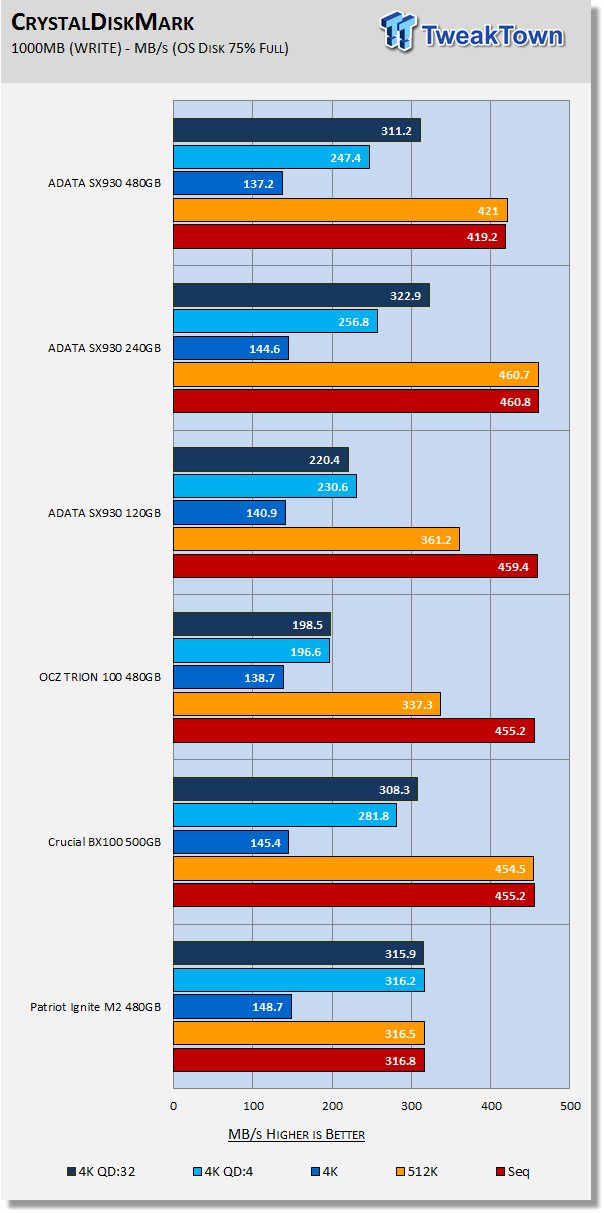
The 240GB SX930 delivers the best all-around write performance of the drives on our chart.
AS SSD
Version and / or Patch Used: 1.7.4739.38088
AS SSD determines the performance of Solid-State Drives (SSD). The tool contains four synthetic as well as three practice tests. The synthetic tests are to determine the sequential and random read and write performance of the SSD.
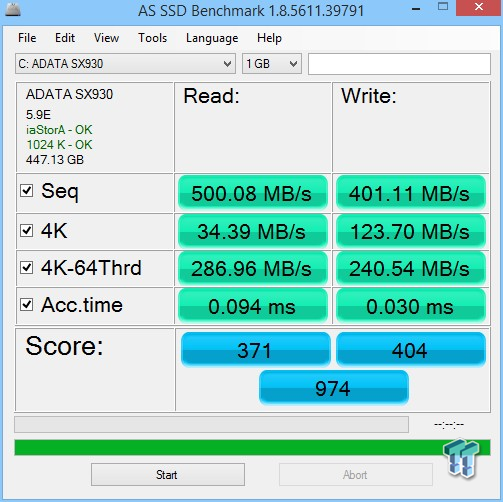
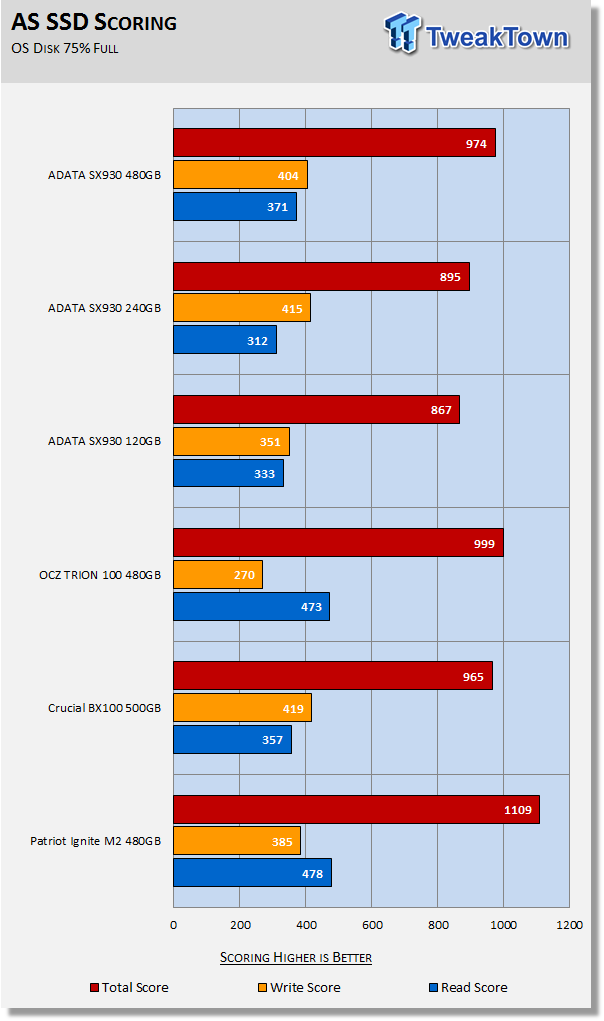
The 480GB SX930 has better high QD random performance than the smaller capacities, resulting in a higher overall score. The Ignite runs away with this test even though it has a sequential write speed of just 300 MB/s.
Benchmarks (Trace Based OS Volume) - PCMark Vantage, PCMark 7 & PCMark 8
Moderate Workload Model
We categorize these tests as indicative of a moderate workload environment.
PCMark Vantage - Hard Disk Tests
Version and / or Patch Used: 1.2.0.0
The reason we like PCMark Vantage is because the recorded traces are played back without system stops. What we see is the raw performance of the drive. This allows us to see a marked difference between scoring that other trace-based benchmarks do not exhibit. An example of a marked difference in scoring on the same drive would be empty vs. filled vs. steady state.
We run Vantage three ways. The first run is with the OS drive 75% full to simulate a lightly used OS volume filled with data to an amount we feel is common for most users. The second run is with the OS volume written into a "Steady State" utilizing SNIA's guidelines. Steady state testing simulates a drives performance similar to that of a drive that been subjected to consumer workloads for extensive amounts of time. The third run is a Vantage HDD test with the test drive attached as an empty, lightly used secondary device.
OS Volume 75% Full - Lightly Used
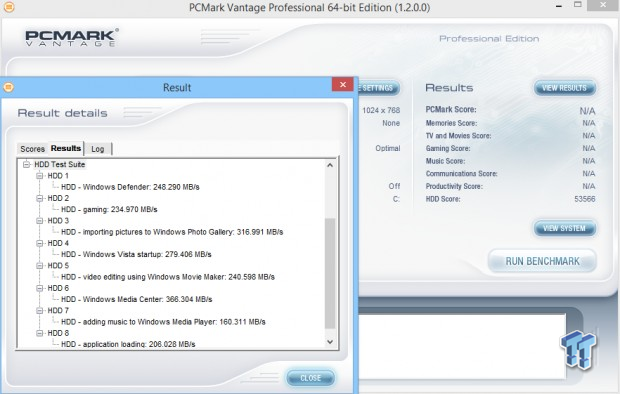
OS Volume 75% Full - Steady State
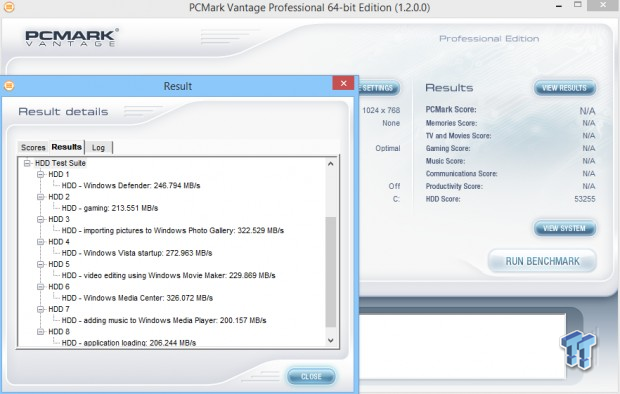
Secondary Volume Empty - FOB
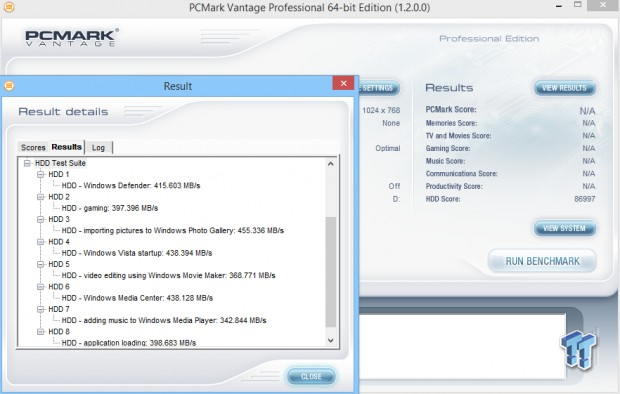
There's a big difference between an empty drive, one that's 75% full/used, and one that's in a steady state.

The important scores to pay attention to are "OS Volume Steady State" and "OS Volume 75% full." These two categories are most important because they are indicative of typical of consumer user states. When a drive is in a steady state, it means garbage collection is running at the same time it's reading/writing. This is exactly why we focus on steady state performance.
Take a look at the filled and steady state scores put up by the SX930's. They are outstanding. Real-world performance is what matters and this is where the SX930 delivers the goods.
PCMark 7 - System Storage
Version and / or Patch Used: 1.4.0
We will look to Raw System Storage scoring for an evaluation because it's done without system stops and therefore allows us to see significant scoring differences between drives.
OS Volume 75% Full - Lightly Used
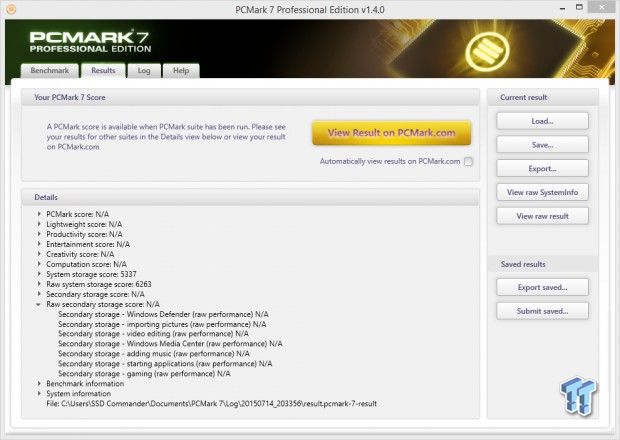
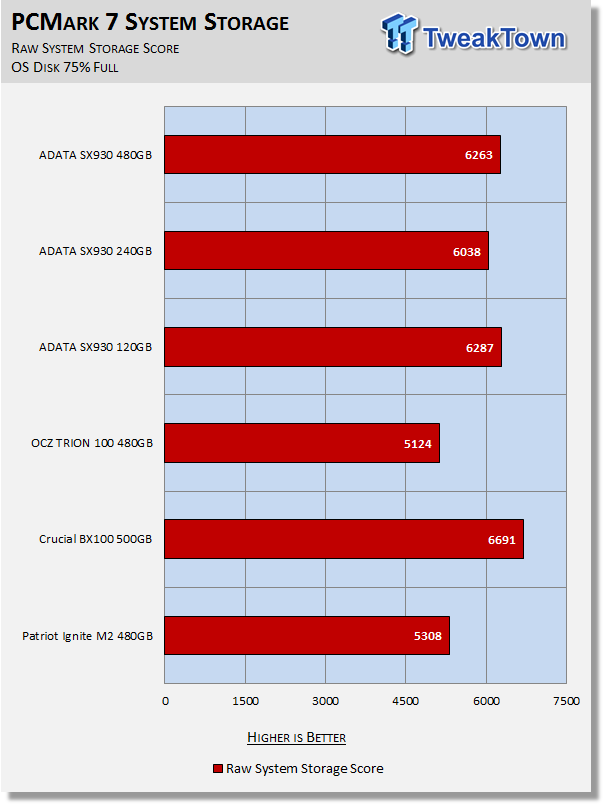
The BX100 wins this test, but the SX930's all perform very well. Just as we saw with our Vantage testing, the 120GB SX930 with its superior QD1 random read performance outperforms both larger capacities.
PCMark 8 - Storage Bandwidth
Version and / or Patch Used: 2.4.304
We use PCMark 8 Storage benchmark to test the performance of SSDs, HDDs, and hybrid drives with traces recorded from Adobe Creative Suite, Microsoft Office, and a selection of popular games. You can test the system drive or any other recognized storage device, including local external drives. Unlike synthetic storage tests, the PCMark 8 Storage benchmark highlights real-world performance differences between storage devices.
OS Volume 75% Full - Lightly Used
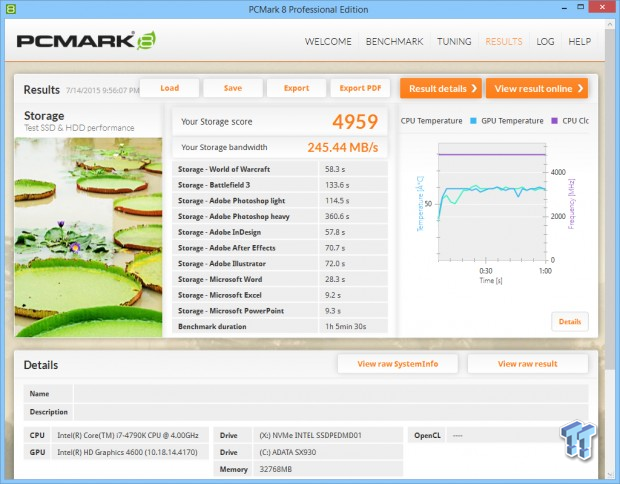
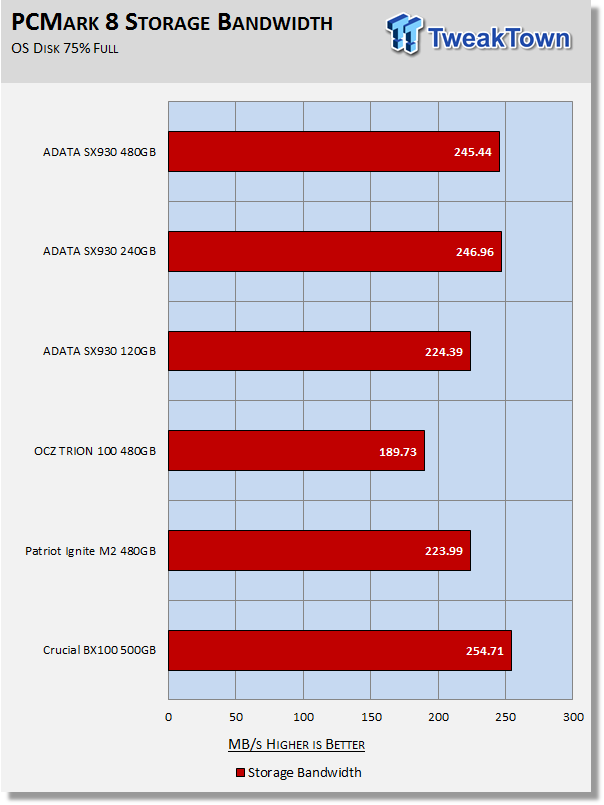
PCMark 8 is the most intensive moderate workload simulation we run. With respect to moderate workloads, this test is what we consider the best indicator of a drive's performance. PCMark is more write intensive than Vantage and PCMark 7 and this is where the larger capacity SX930 drives have the advantage over the 120GB drive. All three perform quite well, but the BX100 has the edge again.
Benchmarks (Secondary Volume) - Max IOPS, Disk Response & Transfer Rates
Iometer - Maximum IOPS
Version and / or Patch Used: Iometer 2014
We use Iometer to measure high queue depth performance. (No Partition)
Max IOPS Read
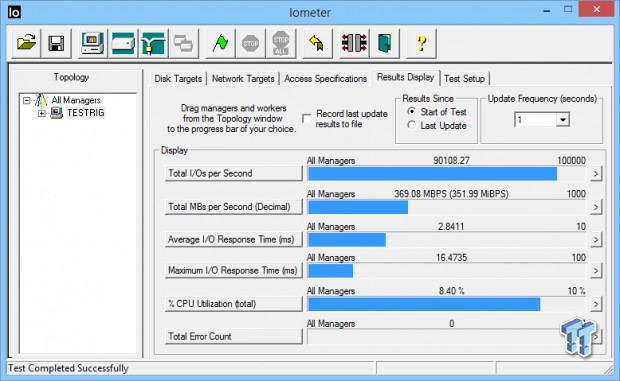
Max IOPS Write
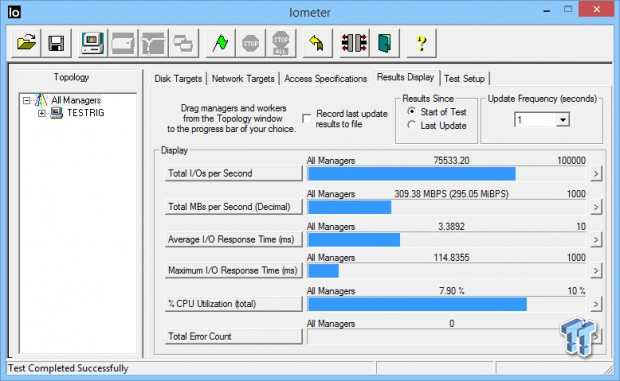
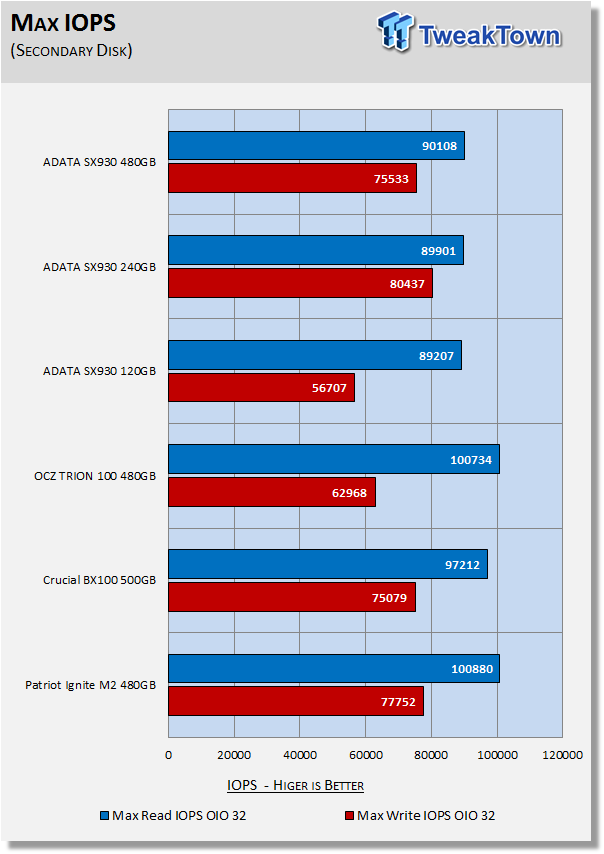
All three of the SX930's exceed ADATA's 4K random read/write specifications. The 240GB SX930 posts the highest 4K random write performance of drives on our chart.
Iometer - Disk Response
Version and / or Patch Used: Iometer 2014
We use Iometer to measure disk response times. Disk response times are measured at an industry accepted standard of 4K QD1 for both write and read. Each test runs twice for 30 seconds consecutively, with a 5-second ramp-up before each test. We partition the drive/array as a secondary device for this testing.
Avg. Write Response
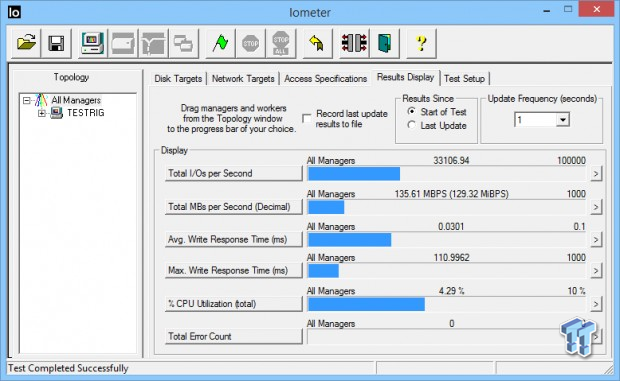
Avg. Read Response
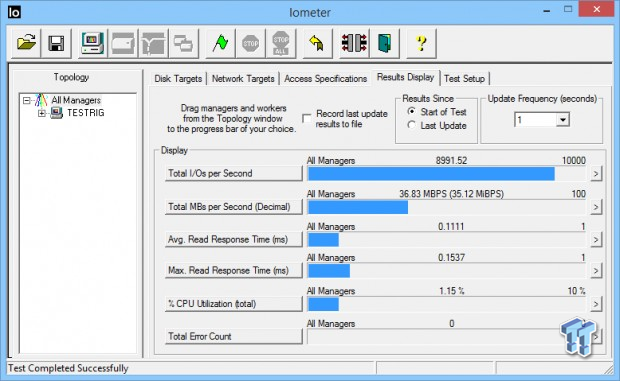
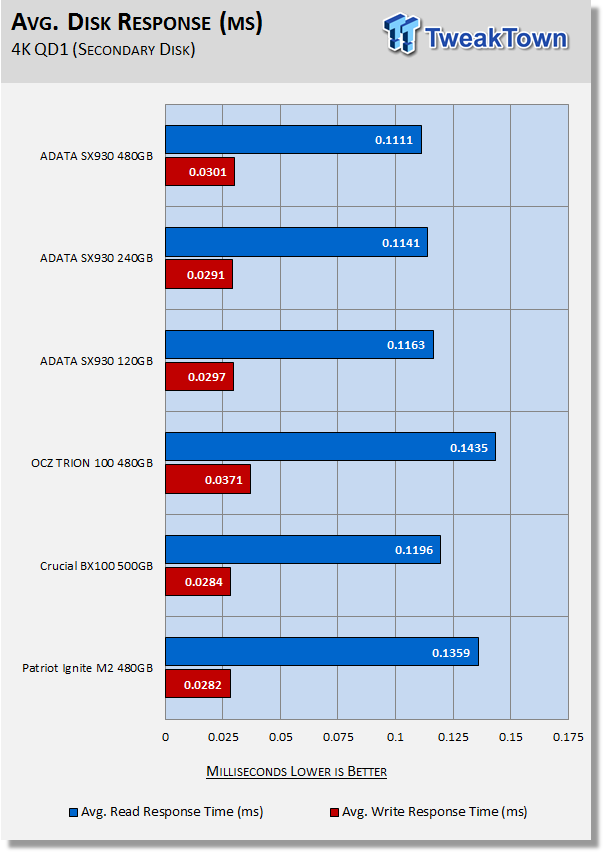
All three capacity points of the SX930 have better read response than the competition. Of the three, the 480GB drive has the lowest read response times. The Patriot Ignite posts the lowest write response times.
DiskBench - Directory Copy
Version and / or Patch Used: 2.6.2.0
We use DiskBench to time a 28.6GB block (9,882 files in 1,247 folders) composed primarily of incompressible sequential and random data as it's transferred from our DC P3700 PCIe NVME SSD to our test drive. We then read from a 6GB zip file that's part of our 28.6GB data block to determine the test drives read transfer rate. Our system is restarted prior to the read test to clear any cached data, ensuring an accurate test result.
Write Transfer Rate
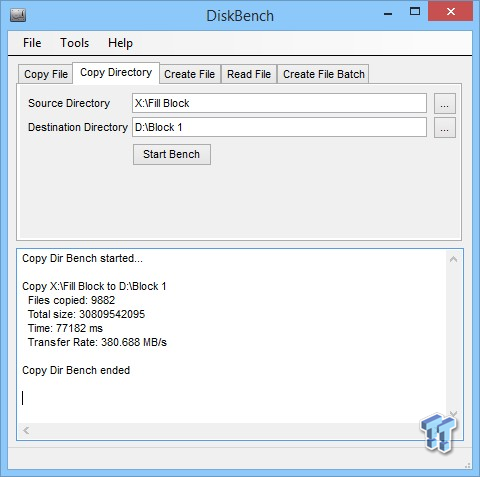
Read Transfer Rate

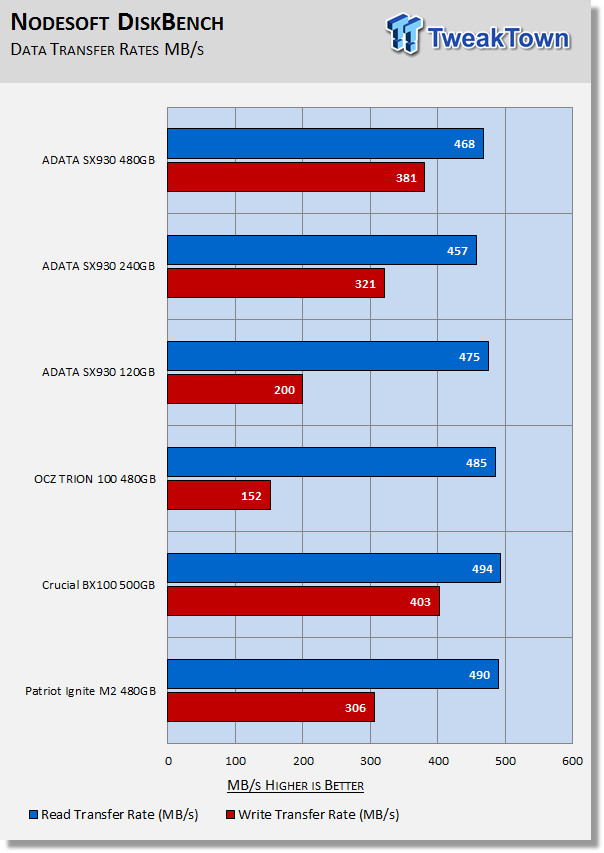
This clearly shows how write transfer rates increase as capacity increases. The 480GB SX930 has the best write transfer rate of the three. The 120GB SX930 has the best read transfer rate of the three. Again, the BX100 has a little more gas in the tank than the SX930's.
Benchmarks (Secondary Volume) - PCMark 8 Extended
Futuremark PCMark 8 Extended
Heavy Workload Model
PCMark 8's consistency test simulates an extended duration heavy workload environment. PCMark 8 has built-in, command line executed storage testing. The PCMark 8 Consistency test measures the performance consistency and the degradation tendency of a storage system.
The Storage test workloads are repeated. Between each repetition, the storage system is bombarded with a usage that causes degraded drive performance. In the first part of the test, the cycle continues until a steady degraded level of performance has been reached. (Steady State)
In the second part, the recovery of the system is tested by allowing the system to idle and measuring the performance after 5-minute long intervals. (Internal drive maintenance: Garbage Collection (GC)) The test reports the performance level at the start, the degraded steady-state, and the recovered state, as well as the number of iterations required to reach the degraded state and the recovered state.
We feel Futuremark's Consistency Test is the best test ever devised to show the true performance of solid-state storage in an extended duration heavy workload environment. This test takes on average 13 to 17 hours to complete, and writes somewhere between 450GB and 14,000GB of test data depending on the drive. If you want to know what an SSD's steady state performance is going to look like during a heavy workload, this test will show you.
Here's a breakdown of Futuremark's Consistency Test:
Precondition phase:
1. Write to the drive sequentially through up to the reported capacity with random data.
2. Write the drive through a second time (to take care of overprovisioning).
Degradation phase:
1. Run writes of random size between 8*512 and 2048*512 bytes on random offsets for 10 minutes.
2. Run performance test (one pass only).
3. Repeat 1 and 2 for 8 times, and on each pass increase the duration of random writes by 5 minutes.
Steady state phase:
1. Run writes of random size between 8*512 and 2048*512 bytes on random offsets for 50 minutes.
2. Run performance test (one pass only).
3. Repeat 1 and 2 for 5 times.
Recovery phase:
1. Idle for 5 minutes.
2. Run performance test (one pass only).
3. Repeat 1 and 2 for 5 times.
Storage Bandwidth
PCMark 8's Consistency test provides a ton of data output that we use to judge a drive's performance.

We consider steady state bandwidth (the blue bar) our test that carries the most weight in ranking a drive/arrays heavy workload performance. Performance after Garbage Collection (GC) (the orange and red bars) is what we consider the second most important consideration when ranking a drive's performance. Trace based steady state testing is where true high performing SSDs are separated from the rest of the pack.
The 480GB SX930 asserts its dominance over the smaller of its brethren in this write intensive test. Overall, the 480GB SX930 outperforms the rest of the field by a large margin. Performance more than doubles with a brief five minutes of recovery time. The 120GB SX930 does not recover a significant amount of performance even after five five minute recovery intervals.
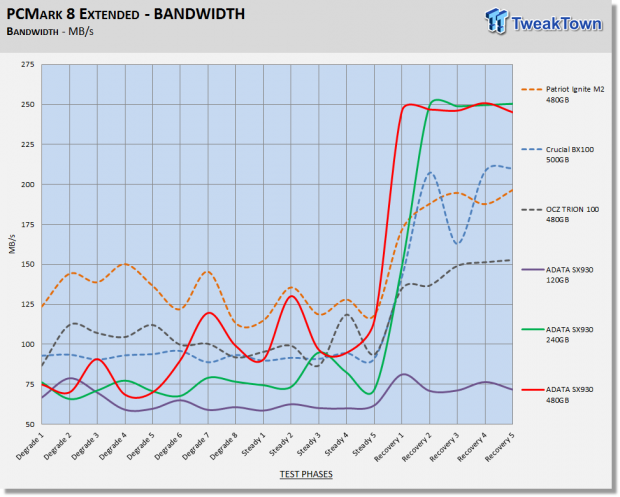
We chart our test subject's storage bandwidth as reported at each of the test's 18 trace iterations. This gives us a good visual perspective of how our test subjects perform as testing progresses.
Total Access Time (Latency)
We chart the total time the disk is accessed as reported at each of the test's 18 trace iterations.
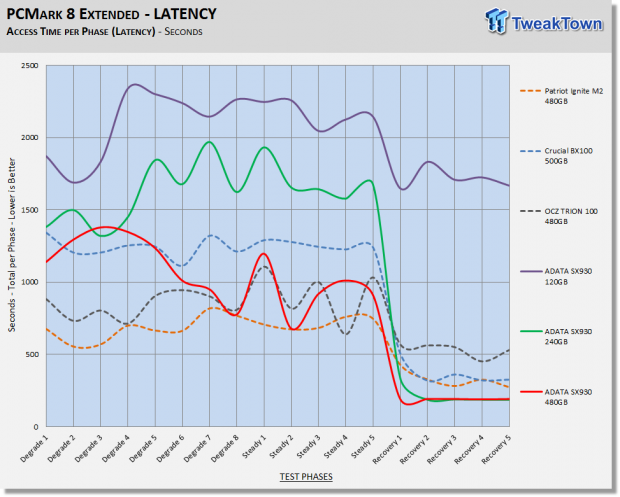
Disk Busy Time
Disk Busy Time is how long the disk is busy working. We chart the total time the disk is working as reported at each of the tests 18 trace iterations.
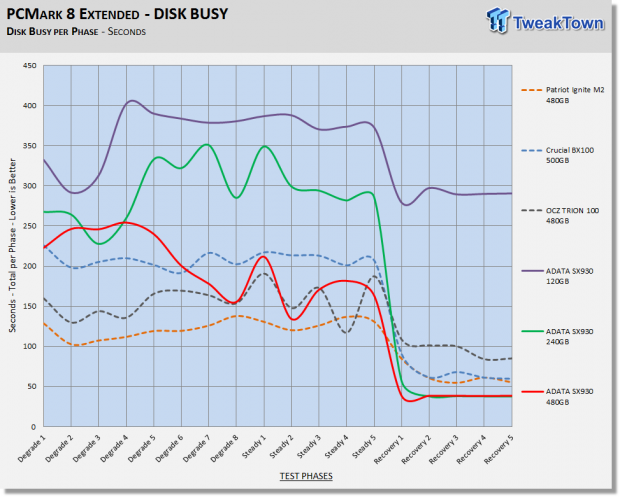
When latency is low, disk busy time is low as well.
Data Written
We measure the total amount of random data that our test drive/array is capable of writing during the degradation phases of the consistency test. Pre-conditioning data is not included in the total. The total combined time that degradation data is written to the drive/array is 470 minutes. This can be very telling. The better a drive/array can process a continuous stream of random data, the more data will be written.
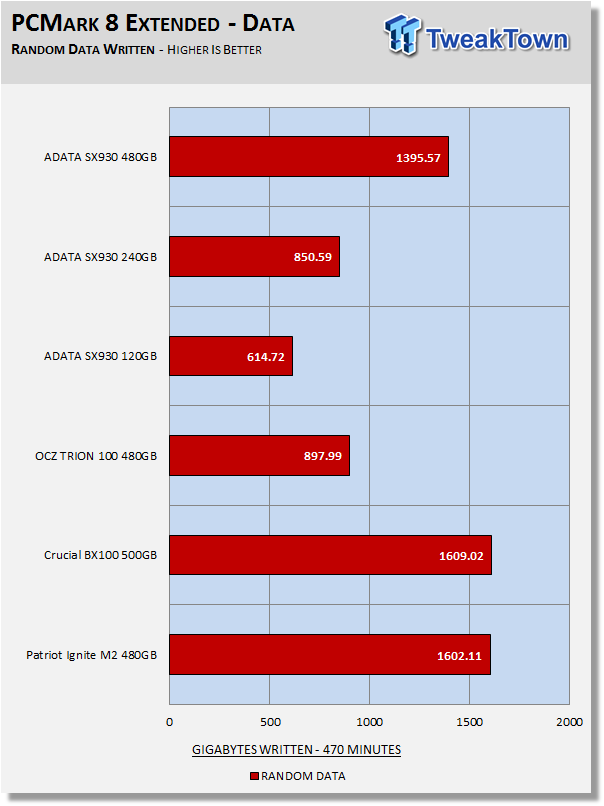
Just as we saw with our transfer testing, the 480GB SX930 has superior write capabilities in comparison to the two smaller capacity points.
Benchmarks (Secondary Volume) - 70/30 Mixed Workload
70/30 Mixed Workload Test (Sledgehammer)
Version and / or Patch Used: Iometer 2014
Heavy Workload Model
This test hammers a drive so hard we've dubbed it "Sledgehammer". Our 70/30 Mixed Workload test is designed to simulate a heavy-duty enthusiast/workstation steady-state environment. We feel that a mix of 70% read/30% write, full random 4K transfers best represents this type of user environment. Our test allows us to see the drive enter into and reach a steady state as the test progresses.
Phase one of the test preconditions the drive for 1 hour with 128K sequential writes. Phase two of the test runs a 70% read/30% write, full random 4K transfer workload on the drive for 1 hour. We log and chart (phase two) IOPS data at 5-second intervals for 1 hour (720 data points). 60 data points = 5 minutes.
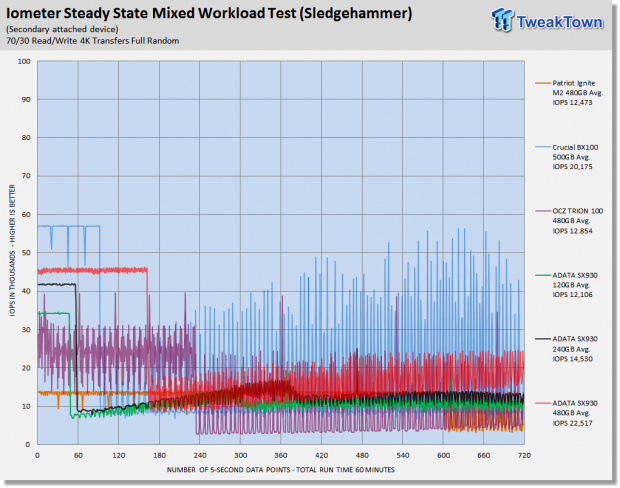
What we like about this test is that it reflects reality. Everything lines up, as it should. Consumer drives don't outperform Enterprise-Class SSD's that were designed for enterprise workloads. Consumer drives based on old technology are not outperforming modern Performance-Class SSD's, etc.
The SX930's performance increases as capacity increases. The 480GB SX930 averages 22,500 IOPS over the span of the test, which is the best performance of the drives on our chart.
Maxed-Out Performance (MOP)
This testing is just to see what the drive is capable of in an FOB (Fresh Out of Box) state under optimal conditions. We are utilizing Windows Server 2008 R2 64-bit for this testing. Same Hardware, just an OS change.
ADATA XPG SX930 480GB
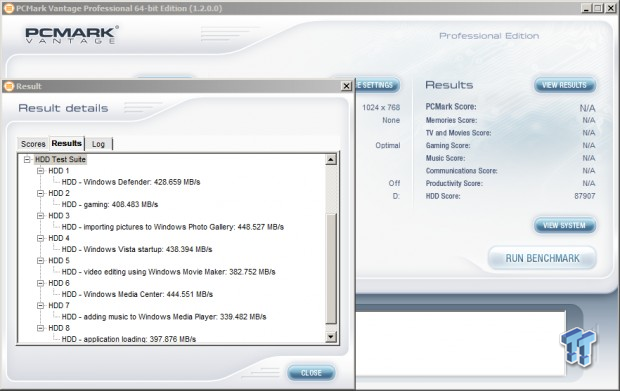
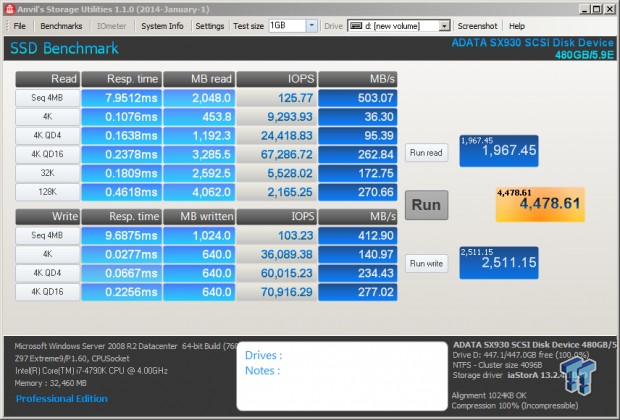
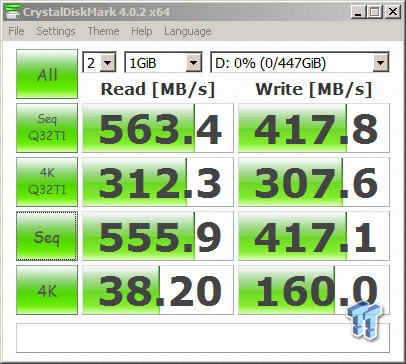
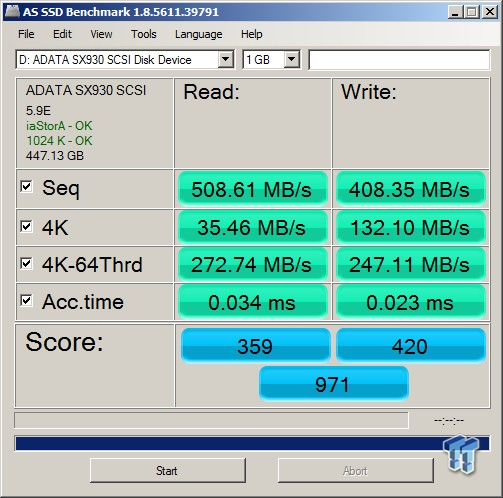
ADATA XPG SX930 120GB
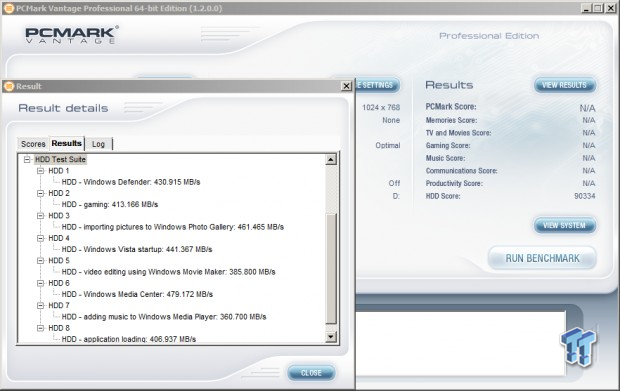

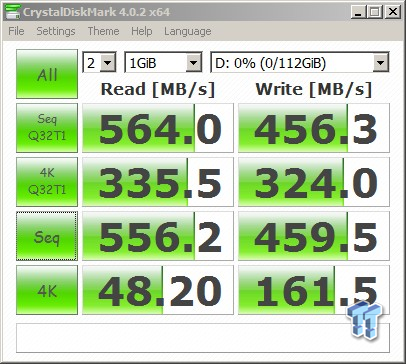
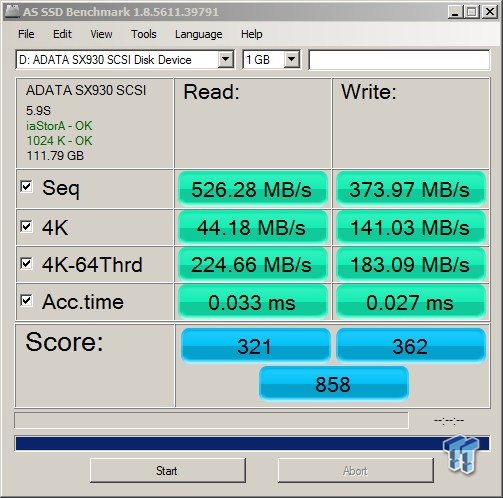
Final Thoughts and Giveaway
Final Thoughts (plus a giveaway)

We like to focus on real-world performance because that is what really matters to the end-user. The SX930 doesn't deliver stellar synthetic performance and that's fine by us, because it performs quite well with our real-world simulations. The 120GB and 240GB drives excel in moderate workloads and the 480GB drive excels with both moderate and heavy workloads. We believe the 480GB SX930 delivers essentially equivalent performance to that of Crucial's BX100 500GB SSD. We feel that the main competition for the SX930 is going to be Crucial's BX100. As long as pricing is equivalent between the 480GB SX930 and 500GB BX100, we give the advantage to ADATA because of SX930's five-year warranty, accessory package, and superior flash.
It is important to note we did not run the SX930 series against our top tier drives. We feel that the SX930 is more of a value-class SSD than it is a performance SSD because of its four channel configuration. We will also note that the drive we consider the fastest SATA-based SSD, Samsung's 500GB 850 EVO, performs about equivalent to the 480GB SX930 when running a heavy workload in a steady-state. It all comes down to pricing. At launch, the SX930 480GB has an MSRP of $200, which is a bit high for our liking and in all likelihood will drop significantly when the drive becomes available through retail channels. We would like to see the 480GB SX930 selling for about $150 to be really attractive. It is also important to consider that the SX930 ships as a complete package. You get everything you could need included when you purchase an SX930, giving it the edge when pricing is equivalent to that of its competition.
Our experience while running the SX930 as our OS volume has been very good. It delivers an excellent SSD experience. You will be hard pressed to tell the difference between it and premium performance-class SSDs. We have no reservations in recommending the ADATA SX930 to our readers, it is an excellent performing SSD with quality flash and a great warranty.
We are pleased with ADATA's XPG SX930 SSDs and we are sure you would like one of your own to supercharge your computing experience.
GIVEAWAY: TweakTown is going to give three lucky readers their own SX930. Each will win one of the three SX930's used for this review. This contest is not sponsored by ADATA and the drives have been opened so they will not carry any warranty. In order to win, leave a comment below and like our Facebook page. Winners will be announced on this page right here, one week from now, on July 30, 2015.
THE WINNERS:
120GB - David Denlinger
240GB - Jason Susavidge
480GB - John Walker
The winners above have been contacted via Facebook message. Please check your "Other" inbox and reply ASAP.
ADATA XPG SX930 SATA III SSD
Pros:
- Quality MLC flash
- Extensive Accessory package
- Five-year Warranty
Cons:
- Random write performance with data on the drive
- MSRP

| Performance | 89% |
| Quality including Design and Build | 89% |
| General Features | 90% |
| Bundle and Packaging | 95% |
| Value for Money | 85% |
| Overall | 90% |
The Bottom Line: An SLC acceleration layer on MLC flash is something we like. The ADATA bundle is one of the industry's most complete and a five-year warranty backing the XPG SX930 will give peace of mind.
PRICING: You can find products similar to this one for sale below.
 United
States: Find other tech and computer products like this
over at Amazon.com
United
States: Find other tech and computer products like this
over at Amazon.com
 United
Kingdom: Find other tech and computer products like this
over at Amazon.co.uk
United
Kingdom: Find other tech and computer products like this
over at Amazon.co.uk
 Australia:
Find other tech and computer products like this over at Amazon.com.au
Australia:
Find other tech and computer products like this over at Amazon.com.au
 Canada:
Find other tech and computer products like this over at Amazon.ca
Canada:
Find other tech and computer products like this over at Amazon.ca
 Deutschland:
Finde andere Technik- und Computerprodukte wie dieses auf Amazon.de
Deutschland:
Finde andere Technik- und Computerprodukte wie dieses auf Amazon.de
What's in Jon's PC?
- CPU: AMD Ryzen 7800X 3D
- MOTHERBOARD: GIGABYTE AORUS Master X670E
- RAM: Kingston Fury Renegade 7200MHz 32GB
- GPU: ZOTAC AMP Extreme GeForce RTX 4090
- SSD: Crucial T700 2TB Gen5
- OS: Windows 11 Pro
- COOLER: Lian Li Galahad 360 AIO
- CASE: Lian Li Lancool III
- KEYBOARD: Corsair K65 RGB Mini
- MOUSE: SteelSeries AEROX 5 Wireless
- MONITOR: ASUS ROG Strix PG27AQN 360Hz 1440p ULMB2
Similar Content
Related Tags

